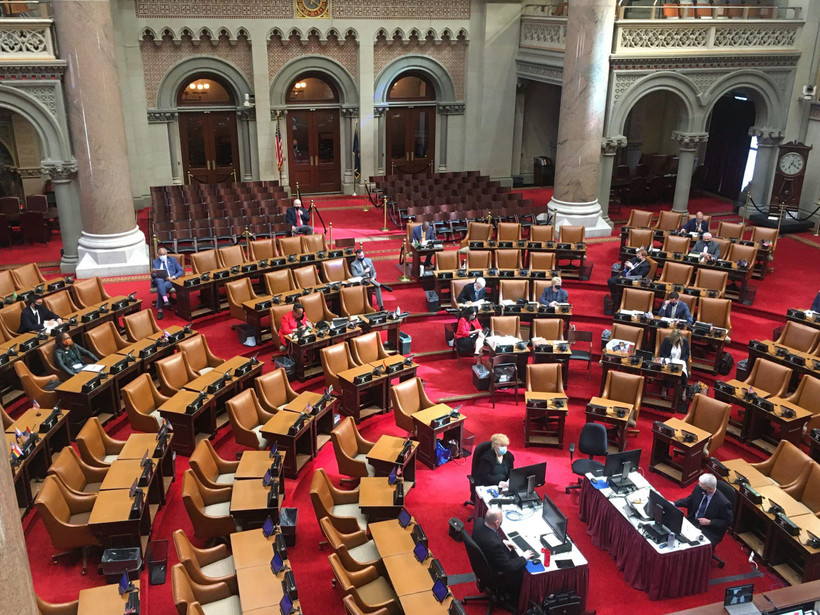What Made It Into the Budget — And What Was Left Out
The major provisions of New York’s 2021 budget.

New York’s legislature is on its way to approving the largest state budget in its history, clocking in at $212 billion.
In many respects, the budget reflects the weakened position of Governor Andrew Cuomo and the strength of the state’s growing progressive wing. It raises taxes on the rich by $4.3 billion, more than any of Cuomo’s previous budgets, even after the state budget director indicated opposition to any significant tax increases.
The budget fully funds aid to school districts under a formula Cuomo once called a “ghost from the past,” marking the end of a decade-long fight by teachers and public education advocates. And it establishes the country’s first excluded workers fund, providing $2.1 billion in cash assistance to workers ineligible for relief under federal stimulus bills. That highly contentious program had been left out of the governor’s executive budget entirely.
But the governor successfully fended off other progressive priorities. The budget raises less than a tenth of the $50 billion in progressive taxation proposed by the Invest in Our New York Coalition, a tax-the-rich campaign led by progressive advocacy organizations. It does not include progressives’ key demands on housing access or harm reduction for people who use drugs, even as both homelessness and overdoses spiked during the pandemic. And it extends a cap on Medicaid spending, introduces a two-tier system of relief for excluded workers that conditions the full amount of aid on hard-to-obtain documentation, and does not advance a dedicated funding source for the state’s emission reduction targets.
Here are the budget’s major provisions.
The budget includes close to $5 billion in new annual revenue, including $4.3 billion in taxes on the rich—the most revenue the state has raised since the 2009 budget, which increased taxes and fees by $6 billion.
$3.5 billion of the haul comes from a hike in the personal income tax rate on New Yorkers earning more than $1 million a year. Taxes on income over $1 million will rise from 8.82% to 9.65%, and two new tax brackets will be created to tax income above $5 million at 10.3% and above $25 million at 10.9%.
The income tax hike is effective through 2027. Just 0.3% of New Yorkers will be affected; around 57,000 New Yorkers made over $1 million in 2018, the last year for which data is available. The new tax rates are still well below California’s rate of 12.3% on income above $600,000—but when combined with New York City’s top income tax rate of 3.38%, make for the highest top rates in the nation.
Another $750 million comes from raising the corporate franchise tax on companies with over $5 million income to 7.25% from 6.5%, effective through 2023, and an estimated $500 million comes from legalizing and taxing mobile sports betting.
The total revenue figure is about two-thirds the $7 billion included in the Assembly and Senate budget proposals, which included capital gains and estate tax increases that didn’t make it into the final budget. And it’s just a tenth of the $50 billion called for by the Invest in Our New York Coalition, a group of the state’s prominent progressive organizations.
But it’s far more than the $1.5 billion reimbursable income tax hike proposed in Governor Cuomo’s executive budget. Cuomo, who has prided himself on avoiding tax increases, likely would have preferred an even lower figure; last month, after it became clear that the state would receive more than twice the amount of federal aid assumed in the executive budget, Cuomo’s budget director indicated that there was no need for a “significant level in tax increases.”
In 2007, responding to a court order to increase state aid to New York City’s school districts, New York State enacted the Foundation Aid formula, which scheduled increases in state spending on public schools. The state implemented the formula for two years—until, reeling from the 2008 financial crisis, it froze school aid in 2009 and cut it by $2.7 billion over the next two years. In the ensuing decade, the state has consistently set school funding at levels below the formula.
This year's budget increases state aid by $1.4 billion this year, amounting to about 35% of the $4 billion the state owes under the formula, and commits to funding the amount owed at 50% next year and 100% in subsequent years.
The budget also distributes $4 billion in federal funds for education from December’s stimulus bill, and school districts will receive another $9 billion in direct funding from the American Rescue Plan.
Jasmine Gripper, the executive director of the Alliance for Quality Education, indicated that the federal aid, which can be spent within the next two years, could be used for multi-year programs—such as expanding internet access, hiring mental health counselors and support staff, and hiring nurses—whose costs tend to be highest in their early years.
“Districts are going to be feeling really confident with this two-tier approach, federal oneshot money and continued state funding,” Gripper said.
On higher education, the budget increased state funds for SUNY and CUNY by $56 million, including a 10% boost to tuition assistance payments, and froze tuition at both university systems for three years. It fell considerably short of the “New Deal for CUNY” bill education advocates have pressed for, but Sen. Andrew Gounardes, the lead sponsor of that legislation, said the budget was nevertheless “arguably the best higher ed budget passed under our current governor.”
The state will distribute $2.3 billion in federal funds to pay up to a year’s rent for tenants in debt to their landlords, as well as $100 million in state funds for tenants ineligible for the federal money.
The distribution program does not include most of the proof-of-eligibility requirements pushed for by Governor Cuomo; it allows tenants to self-attest that they make under 80% of the median income in their areas and meet other requirements for eligibility. In two other provisions that the governor had pushed back against, the budget requires landlords who accept the funds to freeze rents and evictions for a year and cancels rent arrears if landlords refuse to accept the funds.
Neither of the two homelessness-prevention programs prioritized by housing advocates made the state budget.
The Housing Access Voucher Program (HAVP), which would have created a Section 8-style rental assistance program to help homeless New Yorkers rent apartments and which proponents said would be the most consequential statewide policy to combat homelessness in recent memory, was dropped due to the governor’s opposition.
“It really symbolizes how little commitment leadership has to homeless New Yorkers,” Paulette Soltani, political director of VOCAL-NY, the grassroots advocacy group that led the push for HAVP, told New York Focus.
“And I’m not talking about Governor Cuomo – I’m talking about the two leaders that are supposed to be leading our state, when we know exactly what’s going to come out of the governor’s office,” Soltani added.
The Housing Our Neighbors with Dignity Act—which would have created a program to purchase distressed hotels and convert them into 100% affordable and supportive housing, with half the units created reserved for the formerly homeless—didn’t make it in either.
But $100 million was allocated for hotel conversions, with a requirement that the legislature approve program language for how it will be spent. The punting of the issue sets up a fight on whether the final program will more closely resemble HONDA or the proposal in the governor’s executive budget, which did not set aside units for the formerly homeless and required only 25% of units to be affordable.
The budget establishes a $2.1 billion excluded workers’ fund, a cash assistance program for New Yorkers who have been ineligible for federal relief payments during the pandemic—the first program of its kind in the country.
Much of that money will go to undocumented laborers who often earn cash wages in the informal economy, such as farm workers, service employees, and street vendors.
But the fund includes a two-tier system pushed by Governor Cuomo that advocates warned could leave many undocumented workers unable to access the full amount of relief. Excluded workers able to provide formal documents such as tax processing numbers or paystubs proving their eligibility will receive $15,600, minus taxes. But without such formal documentation, which advocates say many workers in the informal economy do not have, workers will receive just $3,200, minus taxes.
The budget enables the state’s Labor Commissioner to allow alternate documents as qualification for the full amount, and immigrants’ advocates indicated they would press the commissioner to accept a wide array of documents. But Senate Finance Committee Chair Liz Krueger said she expects “very few people” to qualify for the full amount.
“I’m not sure if all the folks that are on hunger strike are going to be able to tap into the help. That’s my biggest concern,” Assemblymember Marcela Mitaynes told New York Focus.
Lawmakers were successful in fending off a controversial measure in the executive budget to override New York City’s landmark emissions regulation law and effectively eliminate requirements that the city’s large buildings reduce their emissions.
The budget also authorized a $3 billion environmental bond act to appear on New Yorkers’ ballots in November 2022. The act was passed as part of last year’s budget, but was subsequently removed from the ballot by the governor. One study found the act could support as many as 65,000 jobs by injecting $6.7 billion in spending on climate change mitigation, clean water, and other projects.
But environmentalists say the $3 billion bond is a minor win given the scale of New York’s projected costs for climate adaptation. Conspicuously absent from the budget is dedicated funding for the Climate Leadership and Community Protection Act, which targets bold emissions cuts but lacks a payment plan. This week, New York Renews, an environmental coalition, launched a campaign to fund the CCIA, a polluter-pays initiative that the coalition estimates would raise $15 billion per year.
Budgets tell you what our government prioritizes.
Another state budget with basically no $ to fight climate change. Kind of worrying we can’t figure out a way to fund a battle that existence depends on us winning.
— Alex Beauchamp (@AlexAtFWW) April 6, 2021
Governor Cuomo had proposed a long list of cuts to health care: a $65 million cut to public hospitals’ indigent care pool, a $94 million across-the-board 1% cut in Medicaid payments, and a 50% cut to the state’s contribution to New York City’s health department, among others. None of these cuts were included in the final budget.
“This is the first budget where I can say we are not really doing anything bad” on health, Assembly Health Committee Chair Richard Gottfried said on the Assembly floor.
The budget required that nursing homes spend at least 70% of revenue directly on resident care, and at least 40% of revenue directly on staff. It did not implement mandates on patient-to-staff ratios, as legislators had proposed and New Jersey recently enacted.
The corporate immunity granted to nursing homes in last year’s budget, at the height of the pandemic, was repealed. “This blanket immunity prevented thousands of families who lost loved ones to COVID-19 from seeking legal recourse, and potentially incentivized nursing home executives to cut corners—endangering staff and residents,” Sen. Alessandra Biaggi, a lead sponsor of the repeal legislation, said in a statement to New York Focus.
The budget did not include a proposal from both chambers’ draft budgets to end the Medicaid Global Cap, a 2011 regulation limiting increases in Medicaid spending to 2 or 3 percent each year. “The cap has perpetuated the notion that Medicaid growth is a problem that requires austerity,” said Lara Kassel, coalition coordinator of Medicaid Matters, in a statement, adding that the group is “deeply disappointed” that the cap was extended.
The budget significantly increased funding for addiction counseling and medication for opioid use disorder in prisons and county jails. Funding for addiction treatment was increased from $3.75 million to $8.75 million in county jails, and from $1.5 million to $11 million in state prisons.
But the budget did not include a bill to establish an affirmative mandate for jails and prisons to provide addiction treatment, leaving some advocates skeptical that conditions will dramatically improve, especially in counties where sheriffs and jail superintendents are resistant to providing treatment.
Two other priorities of harm reduction advocates—to repeal prior authorization, which advocates say delays addiction treatment for Medicaid enrollees, and to decriminalize the possession of syringes—also didn’t make the budget. “We are still very very disappointed that this state budget does not reflect evidence based solutions in a moment of extreme crisis,” Jasmine Budnella, drug policy coordinator for VOCAL-NY, told New York Focus.










